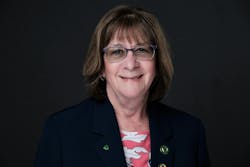Pam Walaski: Don’t Lose Sight of What Matters Most
Pam Walaski, CSP, FASSP, is forgoing the ladder for a wide net. She’s on a mission to bring as many people as possible into the fold and up through the ranks.
“I did it and now I’m doing it for other younger members,” she says.
Walaski is the owner of RiverLure OSH Services and an instructor of occupational safety and health courses at several universities across the country.
She has been involved with the American Society of Safety Professionals (ASSP) since 2003. She is now president of the organization as well as chair of the ASSP Foundation, the organization’s charitable arm through June 30, 2025.
Walaski’s 30 years in workplace health and safety as well as her experiences as an educator, author, editor and speaker afford her a unique perspective of the profession. One thing is certainly clear: She’s going to use her time at the helm of ASSP to be the change she wishes to see.
EHS Today’s Managing Editor Nicole Stempak spoke with Walaski about her plans for the coming year. Their conversation has been lightly edited for clarity and for length.
What will you focus on as president?
Like many organizations, ASSP is still navigating its way to whatever post-pandemic is going to look like. Fortunately, we came out of it financially solid, but we are still not back in terms of gross revenues, so we’re continuing to try to navigate that all underneath the 2023-2028 strategic plan that we approved in June 2023.
We’re also developing tools and resources for occupational safety and health professionals and related fields to meet current needs while anticipating future needs. We had a workforce development task force that met and identified the myriad of ways in which people come intoand out of this profession: What are they? Who are they? What do they need? What can ASSP do to meet their needs?
We're trying to make sure that we're meeting their needs with products and services with the ASSP Foundation. The Foundation is a 501(c)(3), which means its mission is to serve all occupational safety and health professionals, not just members of our soceity. So, the kinds of activities and opportunities that they'll be working on will be available to anyone in the profession. You do not have to be a member of ASSP, which I think is really important as it's the Foundation's mission to advancing the profession as well as advancing professionals. I'm excited to see what's going to come out of that. I think that's going to be really interesting and really helpful.
And we’re just finishing a major revamp of our entire website. That’s hopefully coming out soon.
There’s been a lot of backlash against diversity, equity, inclusion and belonging (DEIB) lately. ASSP has been pretty vocal on the topic, so I wondered if there’s anything you’d like to add to the discussion.
I’ve been listening to the reports as well, and I am dismayed. I think a lot of what I’ve been reading or hearing suggests that organizations saw DEIB as the newest flavor of the month, or the thing that they needed to do. Now, they’ve moved on to something else. Whatever that something else is, I can’t say.
I can only tell you that ASSP is committed to DEIB. It’s a part of all of our standard operating guidelines. It’s a part of all of the decisions that we make. We've been working on that for a couple of years now, and it's really involved identifying barriers to the profession and to our membership in terms of their engagement with the society and finding ways to remove those barriers to be more equitable.
The other group that is getting more attention under the DEIB umbrella are folks who are neurodivergent, folks who may have autism, ADHD or different ways of learning. We're still trying to understand what that means for people in the workforce and how we need to be sensitive to that. So for us as occupational health and safety professionals, it affects us as workers but it also affects the people we work for.
I think sometimes the backlash comes from the diversity around what people look like, what their gender is, their age, those obvious physical characteristics. But diversity is also diversity of thought and diversity of experiences. It’s not helpful—and it’s not productive—to push that away and say, “I don’t want to hear from you. Go sit in a corner somewhere.”
The same thing that was done to other people. We don’t make advances by making that same mistake. We need to continue to engage in dialogue and discussion and find a common ground to support all of our members, no matter who the are or how they identify. It's really important.
What do you want to see more of from the industry?
Over the years, I’ve heard plenty of complaints from my fellow professionals about “I can’t get management to listen to me,” and “They think I’m just overhead.” Those are real challenges that we’ve been struggling with.
But thinking of ourselves as a trusted advisor and adopting that mindset helps our members become that kind of influential leader they may not be right now. That means giving them the tools and the techniques that they can take back to their organizations.
Some of our members work for organizations where there are hundreds and hundreds or even thousands of people in their department, but that’s not the case for a lot of folks. Many of our members work for very small departments. We have to make sure that we have the opportunity to help them as well.
I appreciate you mentioning influence, because we often write about how you don’t need to have leader in your title in order to be a leader at your organization.
It’s funny that you say that because some of the things we try to offer our members in terms of that trusted advisor role are various kinds of development skills, not technical skills. Some people call them soft skills. The term I’ve settled on is nontechnical essential skills. That's really what we're talking about here.
If I’ve been in the profession for five or six years, I know where to go to find the answer for how high the guardrail has to be. That’s not hard; it’s a technical skill. Eventually, that will get stuck in my head, and I won’t have to go look it up. But as long as I know where to find that technical information, then I can build my credibility in that area.
My credibility also rests in those nontechnical essential skills in terms of how I interact with people, how I engage with leaders and how I show up every day as a member of my organization. No matter what you do, whether you have a manager after your title or not, you want to be an influencer in your organization.
What do you want to see less of?
That’s a good question! I don’t want to take away from the responsibility of an organization to comply with regulatory requirements, but I would like to see more organizations not base their decisions on what OSHA says they have to do. I respect what OSHA does. I understand we all have to comply with the regulations.
But when somebody asks us a question about what we should do, we have to stop pivoting to “OSHA says…” and start pivoting more toward managing risk and other kinds of emerging approaches. We have to retrain our organizations to think differently about what it is that we offer as a profession. To some degree, we have to lead that charge and help them focus less on it.
I appreciate you mentioning that because OSHA is a federal agency. They have to adhere to their rulemaking process, and there are things OSHA simply cannot do.
Well, and the elephant in the room is that we are in an election year, so expecting anything out of OSHA this calendar year, even in the initial stages, is not reasonable. That happens every four years.
That means we need to continue to rely on ourselves. We need to continue to use the ANSI standards, of which ASSP is a secretariat. We have 15 different standards committees promulgating and publishing standards. We’re active with the ISO, both 45001 and the family of standards that’s coming out underneath that. That’s really where I prefer that we spend our time and energy.
ASSP has recently addressed a number of topics affecting subsets of the workforce, including heat stress and child trafficking and child labor laws. Could you speak about these?
Heat stress is one of the most significant hazards. We’re not doing a very good job at controlling it from a regulatory standpoint, and I’m proud to see the committee release the heat stress standard under ANSI. It provides our members with the kind of guidance they need to address that particular hazard. There are some states that have heat stress programs, but they focus on particular industries, such as agriculture. The ANSI standard is focused on a broader range of hazard identifications and controls.
The child labor position paper that we published recently was really significant, and the group that worked on it did an excellent job. Shining a light on that particular problem is important to our members and to workforce development everywhere.
From my viewpoint, it seems like ASSP is focusing on members of the workforce who don’t always get a lot of attention and who might not be able to speak up for themselves.
Absolutely! If you look at the fatalities from the previous year, there were a number of teen workers who perished or were significantly injured. They should not have been doing the kind of work they weredoing. It was not only too hazardous for them, but it was also illegal in some of the states—not in terms of occupational safety and health—but a labor issue in terms of what kind of work people can be doing. That’s a real challenge. I’m glad we responded with a very strong statement about it.
How is the safety profession evolving?
The profession has been undergoing a number of key changes over the years. One has been the identification of management systems as the foundation of a workplace program, as opposed to compliance with OSHA, as well as the influence of risk management.
As Todd Conklin says, "We must stop seeing workers as problems to be fixed. But, as solutions to be harnessed." So, looking at the work and how the worker engages in their day-to-day responsibilities as part of the system that they work in. It's not isolated. We have the best opportunity to make progress by recognizing how to address the systemic issues as opposed to address the worker issues.
We have a long history of fixing the worker, but I'm glad to see us evolving away from that and see other kinds of approaches that empower the worker, that allow us as professionals to partner with workers as opposed to that safety officer relationship.
Is there anything about safety that keeps you up at night?
What bothers me is our lack of progress on fatalities and serious injuries. There are people who are working at heights, in confined spaces, in trenches, or with very dangerous machinery. These are hazardous tasks and hazardous activities, to be sure, but we know how to control that. And those fatalities, to me, represent a failure to control those kinds of hazards. I think it’s important for us to keep our focus on that.
By the time this article comes out, Workers’ Memorial Day will be over, but it’s an opportunity for us, as professionals, to really pause, remember and reflect on people who lost their lives doing things that can be done safely and with an acceptable level of risk.
We know how to do it. We know how to go into a confined space. We know how to go into a trench safely and when we should get out, but we continue to struggle with those areas. That is frustrating.
In October 2023, the ASSP board had the opportunity to attend the dedication of the Triangle Shirtwaist Factory Fire Memorial in New York City. One of the things a speaker said during the dedication ceremony was that we are the keepers of their memories. I think about that all the time. We, as occupational safety and health professionals, are the keepers of the memories of those folks who died in 1911, the people who died in 2023 and everybody in between. We are the ones who continue to advocate for their memories and the people impacted by their loss. To me, that's the highest calling of our profession.
Is there anything that we haven’t discussed that you would like to mention?
We recently held our society elections. We’ve had female presidents before. We’ve had two times where we’ve had back-to-back women presidents, but we just elected a woman senior vice president. So, we will have, for the first time, three female presidents consecutively: myself, Linda Tapp and Monique Parker.
That’s exciting to me because of the many struggles lots of women have in this profession—and continue to have in this profession. The thing that always resonates with me is that if you can see it, you can be it. Monique is a Black woman, so she will be the first Black female president we’ve ever had. We’ve had a Black male president in Darryl Hill.
As a society, we are modeling what we’re asking our members to do. I think that’s important.
About the Author
Nicole Stempak
Nicole Stempak is managing editor of EHS Today and conference content manager of the Safety Leadership Conference.


